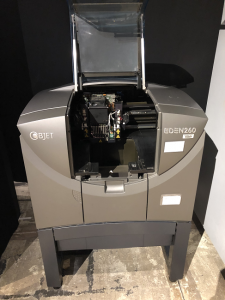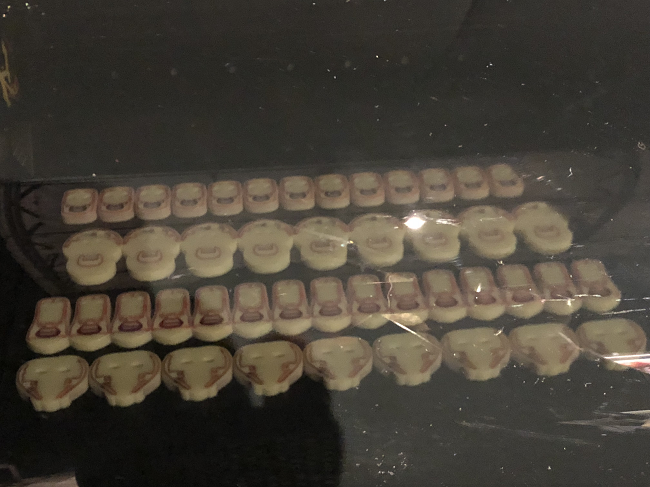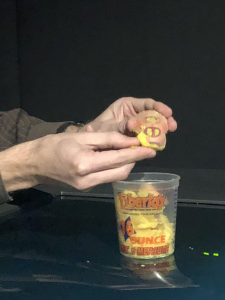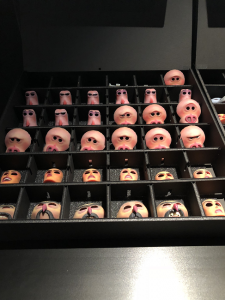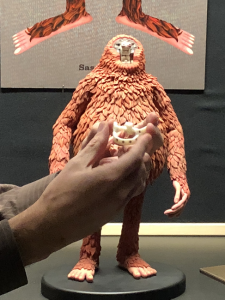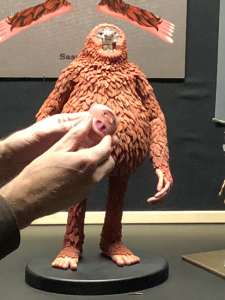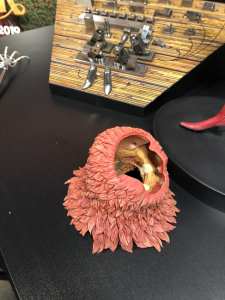While attending SOLIDWORKS World 2019 in Dallas recently, I learned during my interview with Stratasys that the company’s multi-material J750 3D printer, which offers over 500,000 different color combinations, was the only 3D printer used during production of Missing Link, the latest stop motion animation film from Oregon-based LAIKA. The movie is about Sir Lionel Frost (Hugh Jackman), an investigator of myths and monsters, and the legendary Sasquatch (Zach Galifianakis), better known as Mr. Link, or Susan. Together with Sir Lionel’s old friend Adelina Fortnight (Zoe Saldana), they set out across the globe on a mission to find the long-lost valley of Shangri-la, said to be home to the Yetis…who just might be Mr. Link’s long-lost cousins.
The film takes place all around the world, including London, a ship on the ocean, a logging town in Santa Ana, snowy mountains, and a forest in the Pacific Northwest…which is where I was last week. I was lucky enough to join a group of other journalists on a behind-the-scenes tour of the studio ahead of the film’s release on April 12th. Take a look at the trailer below:
It took LAIKA roughly five years to make Missing Link, which director and writer Chris Butler called its “most ambitious film to date.” It was also the first to feature bespoke facial animation, as the Stratasys J750 was used to create the film’s over 106,000 3D printed faces. Thanks to the “amazing level of nuance” of the characters’ facial expressions, it’s much easier to become emotionally invested in these silicone puppets for a full-length feature film. LAIKA uses Maya to design the 3D printable faces for its stop motion puppets, which easily snap on and off with coded magnets…an ingenious solution for switching the many facial expressions that make up a character.
 While on the tour, we had the chance to see plenty of movie magic, and speak to the people responsible for making it happen, including the studio’s head of production, costume designer, creative lead, practical effects director, supervising production designer, and VFX supervisor. The only thing that could have made the day better, at least in my book, was if Hugh Jackman himself had strolled in during the tour…which sadly did not happen.
While on the tour, we had the chance to see plenty of movie magic, and speak to the people responsible for making it happen, including the studio’s head of production, costume designer, creative lead, practical effects director, supervising production designer, and VFX supervisor. The only thing that could have made the day better, at least in my book, was if Hugh Jackman himself had strolled in during the tour…which sadly did not happen.
However, we did get the chance to hear from Brian McLean, LAIKA’s Director of Rapid Prototyping, about the studio’s use of 3D printing to make the faces for its stop motion animation characters. LAIKA is no stranger to Stratasys technology, having worked with its J750 3D printer since 2015, but its 3D printing journey began long before then.
The studio’s first 3D printer, which was used to make the faces for its 2009 film Coraline, was the compact Objet Eden260 from Stratasys, which uses Polyjet technology and has been used to create other stop motion animation projects in the past. This 3D printer jets down liquid resin and liquid support in very fine layers, which are then cured by UV lights.
“The reason why we chose this technology was because it was known for its precision and known for its accuracy, especially those fine feature details,” McLean explained.
Because the Objet Eden260 was a single material system, the faces for Coraline were all 3D printed in white resin and then hand-painted. While McLean said the 3D printer was “amazing,” he noted that it did rather limit the level of sophistication that could be used when painting the characters.
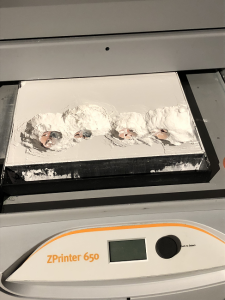 The next logical step was color, which is why LAIKA used 3D Systems’ ZPrinter 650 (now known as the ProJet 660Pro) for its films ParaNorman and The BoxTrolls, as it was the only color 3D printer on the market at the time, though McLean said it “was a bear” to work. The ZPrinter 650 features colored glue in cyan, yellow, and magenta, which is sprayed through an inkjet head onto fine layers of white powder.
The next logical step was color, which is why LAIKA used 3D Systems’ ZPrinter 650 (now known as the ProJet 660Pro) for its films ParaNorman and The BoxTrolls, as it was the only color 3D printer on the market at the time, though McLean said it “was a bear” to work. The ZPrinter 650 features colored glue in cyan, yellow, and magenta, which is sprayed through an inkjet head onto fine layers of white powder.
Unfortunately, this 3D printer only provided a 60% yield on LAIKA’s 3D printed faces, because the dry powder is exposed to the ambient temperature and humidity in the studio. In McLean’s words, Portland is “rainy as hell,” which means that the powder is absorbing lots of humidity. So any puppet face that’s 3D printed will come out looking different in the winter than it does in the summer, which doesn’t do a lot for consistency. That’s why LAIKA was excited to enter the world of resin color 3D printing.
“We had resin in just black and white, then we had color, but the color was powder. The goal had always been, and the exciting thing was, as soon as we can get colored resin, then we have the best of both worlds – we have the precision and the accuracy and the repeatability, but we can add color,” McLean explained.
 LAIKA used the Stratasys Connex3, which wasn’t in the room during the tour, to help create three characters for its 2016 film Kubo and The Two Strings. Unfortunately, it only offered a total of three mixable color options. But then Stratasys came out with the J750, which “gave you the ability to print six colors at once.” LAIKA was actually a beta user for the J750, before immediately purchasing “the first five off the assembly line” once the multi-material system was officially released.
LAIKA used the Stratasys Connex3, which wasn’t in the room during the tour, to help create three characters for its 2016 film Kubo and The Two Strings. Unfortunately, it only offered a total of three mixable color options. But then Stratasys came out with the J750, which “gave you the ability to print six colors at once.” LAIKA was actually a beta user for the J750, before immediately purchasing “the first five off the assembly line” once the multi-material system was officially released.
“So long story short, we saw this technology, we thought it was where the industry was going, and we got a few of the printers in,” McLean said.
“The hardware that Stratasys had created was really cool, but the software was really limiting, and we ended up partnering with an independent software developer that allowed us to do this really advanced color placement with resin placement.”
McLean explained that after a conference presentation on The BoxTrolls, a LAIKA employee ended up sitting next to a representative from the far-reaching Fraunhofer research organization, who mentioned the organization’s Cuttlefish advanced slicer software. Fraunhofer’s software, which McLean said “saw through” voxel and resin development, intrigued the studio.
“We take for granted a lot of color technology because of the decades that have gone into color calibration in 2D printing,” McLean said. “We’re very used to being able to see a picture on our computer screen and print it out on our inkjet printer and the colors come out pretty accurate.”
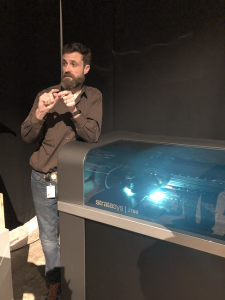 Stratasys was willing to let LAIKA use Cuttlefish with the Connex3 and J750, but when it released the GrabCAD Voxel Print software solution in 2017, its software capabilities were expanded to allow for, among other things, better control of voxel-level colors.
Stratasys was willing to let LAIKA use Cuttlefish with the Connex3 and J750, but when it released the GrabCAD Voxel Print software solution in 2017, its software capabilities were expanded to allow for, among other things, better control of voxel-level colors.
“So we were able to leverage the research that Fraunhofer had done, combine it with the hardware that Stratasys had created, and during the production of ‘Missing Link,’ we were able to produce 3D color printed faces that literally no one else in the world had the sophistication to do.”
The J750 also works fast, as McLean explained that a whole row of unique character faces, with different expressions, can be 3D printed in about an hour and 35 minutes.
“Complexity doesn’t add time to the printing process,” he explained. “The only thing that adds time to the printing process is how tall an object is.”
McLean also showed us the “nightmare fuel” of what was underneath the 3D printed puppet faces, calling the whole set-up “really fancy Mr. Potato Heads.” The faces are more like 3D printed masks with eye holes, while the eyes underneath can be subtly moved with an X-acto knife.
“We will spend anywhere between six months to sometimes even as long as a year designing the character’s head,” McLean said. “And when I say designing the character’s head, I’m not talking about what he looks like, I’m talking about what the audience never sees – the internal components. And the reason we spend so much time is we want to give the animators ultimate control when they’re out on set.
“People have heard that cliche saying – the eyes are the windows to the soul. There’s a tremendous amount of performance and life that the animators are pumping through these characters through the eyes. So we want to make sure that this little mechanism that we’ve created and engineered is going to give them the ultimate control that they need.
“Certain animators will want different tension…some animators want the eyeball to be loose, other animators want the eyeball to be tight. Or they’ll want the lid to be loose, and other ones want it tight. So this [mechanism] you can independently tension the eyelid or the eyeball. Now the thing that’s really crazy about certain eyelids is that this is just a vacu-formed thin sheet of plastic. But when you watch it animate, you can’t tell that that’s just a thin piece of plastic.”
LAIKA needed to find an innovative way to animate both the face and the connecting fur of the character Mr. Link, whom McLean hilariously referred to as “an avocado with a face.” It took the studio over a year to come up with a driver system, which is 3D printed out of strong ABS and has embedded magnets inside, which push and pull the fur of Mr. Link’s head into shapes that match the rest of the face.
By using 3D printing to make the faces, the studio is taking the “normal steps of animation and flipping it on their heads.”
“Normally in animation…the animators will go through, they’ll draw it out, they’ll block out the scene, they’ll get the body movements all defined and the timing just right and the acting, and then the last thing that they do is they add the facial animation on top,” McLean explained. “We’re doing facial animation months before an animator’s even on set with their puppet. Because of our process of needing to animate faces, send them to the printer, print out hundreds and hundreds of faces for a shot, process them, test them, and deliver them, we need months to do that. So when an animator is out on set, they are doing a live action performance with the body, they’re capturing it in real time frame by frame, but the facial animation is already pre-determined and already locked down.”
 When asked, McLean said they have thought about 3D printing the puppets themselves, especially as the technology is being slowly adopted throughout the various departments in LAIKA. So we’ll see what comes next for the innovative studio.
When asked, McLean said they have thought about 3D printing the puppets themselves, especially as the technology is being slowly adopted throughout the various departments in LAIKA. So we’ll see what comes next for the innovative studio.
Missing Link comes out on April 12th, and I for one can’t wait to buy my ticket…I haven’t even seen it yet and I’m already emotionally invested in these amazing puppets.
Discuss this story and other 3D printing topics at 3DPrintBoard.com or share your thoughts in the Facebook comments below.
[Images: Sarah Saunders for 3DPrint.com]


